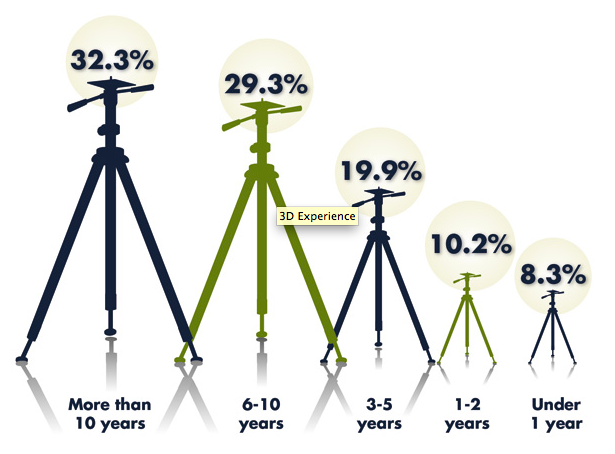How experience, industry, company-size, age, gender, and more affect compensation and job satisfaction
PORTLAND, Maine – In September 2011, SPAR 3D surveyed 362 3D laser scanning and data capture professionals across a variety of verticals and global geographies to better understand the impact of 3D laser scanning and data capture skills on compensation and to gauge respondents’ attitudes regarding their job satisfaction and their beliefs regarding the commercial prospects for this new technology.
Along the way, we gathered data on age, gender, education, experience, company size, tenure, and much more to see how those factors further affected compensation in our growing and changing industry. We also gathered evidence, both statistical and anecdotal, about 3D professionals’ job satisfaction and outlook on the industry as a whole.
The result is a 32-page report that’s now available for download.
For a sample of the data, see our series of infographics that tell you how age, gender, education, experience correlate with salary.
What we found is that, as a group, 3D pros are highly educated (most have at least a college degree, if not a Master’s or a Ph.D.), have several years of experience, and have several years of tenure with their current company. Their organizations are highly diverse in terms of geography, company revenue, industry, and client industry. Most respondents work for engineering or service contractors, with a substantial minority who work for hardware or software providers.
And they’re a positive lot: Most respondents expect to earn more in 2011 than they did in 2010.
Almost all survey respondents report they are satisfied with their careers, and almost 40 percent say they are very satisfied. Most survey respondents are enthusiastic about their work; they say their work is interesting, challenging, and provides a great deal of variety. Many like the challenge of solving new problems and working with cutting edge technology. Quite a few also mentioned that working with talented colleagues and teams contributes greatly to their overall job satisfaction.
How’s that for a recruiting tool?
Of course, this is a first pass. There’s no way to know how these results will stand up to repeated surveys. The results are affected by the quality of our lists here at SPAR, the types of people who are prone to answer these sorts of survey (and who were interested in a set of data as a reward for their participation). It was a web-based survey, deployed via email to the folks who get SPARView. There were 362 responses received and utilized for this report, for a response rate of 4 percent. Not bad for a long survey like this one.
Based on 362 respondents, the maximum error rate for the overall percentages is ± 5.10% at a 95% confidence level. That is, in 95 of 100 similar samples, the overall percentages would fall within 5.10 percentage points of those observed in the data tables. This error rate assumes the responses are normally distributed; we have not tested the validity of this assumption.
Obviously, for those questions that narrow the field of respondents further, the error rate increases. Should you come across a bucket of people (say those in the profession who are under the age of 25) that is relatively small, you should take their average salary with a grain of salt. However, we did our best to eliminate any junk responses and to present to you what we feel is the best data currently available about salary and compensation trends for 3D data capture and laser scanning professionals.
To download the full report, go here. To sample the data via infographics, go here.






